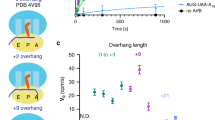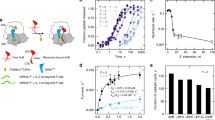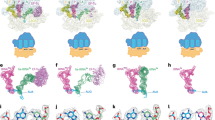Abstract
During cellular translation of messenger RNAs by ribosomes, the translation apparatus sometimes pauses or stalls at the elongation and termination steps1,2,3,4,5,6. With the exception of programmed stalling, which is usually used by cells for regulatory purposes5,7,8, ribosomes stalled on mRNAs need to be terminated and recycled to maintain adequate translation capacity9. Much ribosome stalling originates in aberrant mRNAs that lack a stop codon. Transcriptional errors, misprocessing of primary transcripts, and undesired mRNA cleavage all contribute to the formation of non-stop mRNAs. Ribosomes stalled at the 3′ end of non-stop mRNAs do not undergo normal termination owing to the lack of specific stop-codon recognition by canonical peptide release factors at the A-site decoding centre. In bacteria, the transfer-messenger RNA (tmRNA)–SmpB-mediated trans-translation rescue system reroutes stalled ribosomes to the normal elongation cycle and translation termination3,4,10,11,12. Two additional rescue systems, ArfA–RF2 (refs 13, 14, 15, 16) and ArfB (formerly known as YaeJ)17,18, are also present in many bacterial species, but their mechanisms are not fully understood. Here, using cryo-electron microscopy, we characterize the structure of the Escherichia coli 70S ribosome bound with ArfA, the release factor RF2, a short non-stop mRNA and a cognate P-site tRNA. The C-terminal loop of ArfA occupies the mRNA entry channel on the 30S subunit, whereas its N terminus is sandwiched between the decoding centre and the switch loop of RF2, leading to marked conformational changes in both the decoding centre and RF2. Despite the distinct conformation of RF2, its conserved catalytic GGQ motif is precisely positioned next to the CCA-end of the P-site tRNA. These data illustrate a stop-codon surrogate mechanism for ArfA in facilitating the termination of non-stop ribosomal complexes by RF2.
This is a preview of subscription content, access via your institution
Access options
Subscribe to this journal
Receive 51 print issues and online access
$199.00 per year
only $3.90 per issue
Buy this article
- Purchase on Springer Link
- Instant access to full article PDF
Prices may be subject to local taxes which are calculated during checkout




Similar content being viewed by others
References
Simms, C. L., Thomas, E. N. & Zaher, H. S. Ribosome-based quality control of mRNA and nascent peptides. Wiley Interdiscip. Rev. RNA 8, e1366 (2017)
Richter, J. D. & Coller, J. Pausing on polyribosomes: make way for elongation in translational control. Cell 163, 292–300 (2015)
Keiler, K. C. Mechanisms of ribosome rescue in bacteria. Nat. Rev. Microbiol. 13, 285–297 (2015)
Himeno, H., Nameki, N., Kurita, D., Muto, A. & Abo, T. Ribosome rescue systems in bacteria. Biochimie 114, 102–112 (2015)
Subramaniam, A. R., Zid, B. M. & O’Shea, E. K. An integrated approach reveals regulatory controls on bacterial translation elongation. Cell 159, 1200–1211 (2014)
Starosta, A. L., Lassak, J., Jung, K. & Wilson, D. N. The bacterial translation stress response. FEMS Microbiol. Rev. 38, 1172–1201 (2014)
Ito, K. & Chiba, S. Arrest peptides: cis-acting modulators of translation. Annu. Rev. Biochem. 82, 171–202 (2013)
Wilson, D. N., Arenz, S. & Beckmann, R. Translation regulation via nascent polypeptide-mediated ribosome stalling. Curr. Opin. Struct. Biol. 37, 123–133 (2016)
Keiler, K. C. & Feaga, H. A. Resolving nonstop translation complexes is a matter of life or death. J. Bacteriol. 196, 2123–2130 (2014)
Giudice, E. & Gillet, R. The task force that rescues stalled ribosomes in bacteria. Trends Biochem. Sci. 38, 403–411 (2013)
Neubauer, C., Gillet, R., Kelley, A. C. & Ramakrishnan, V. Decoding in the absence of a codon by tmRNA and SmpB in the ribosome. Science 335, 1366–1369 (2012)
Ramrath, D. J. et al. The complex of tmRNA–SmpB and EF-G on translocating ribosomes. Nature 485, 526–529 (2012)
Chadani, Y. et al. Ribosome rescue by Escherichia coli ArfA (YhdL) in the absence of trans-translation system. Mol. Microbiol. 78, 796–808 (2010)
Kurita, D., Chadani, Y., Muto, A., Abo, T. & Himeno, H. ArfA recognizes the lack of mRNA in the mRNA channel after RF2 binding for ribosome rescue. Nucleic Acids Res. 42, 13339–13352 (2014)
Shimizu, Y. ArfA recruits RF2 into stalled ribosomes. J. Mol. Biol. 423, 624–631 (2012)
Chadani, Y., Ito, K., Kutsukake, K. & Abo, T. ArfA recruits release factor 2 to rescue stalled ribosomes by peptidyl-tRNA hydrolysis in Escherichia coli. Mol. Microbiol. 86, 37–50 (2012)
Chadani, Y., Ono, K., Kutsukake, K. & Abo, T. Escherichia coli YaeJ protein mediates a novel ribosome-rescue pathway distinct from SsrA- and ArfA-mediated pathways. Mol. Microbiol. 80, 772–785 (2011)
Handa, Y., Inaho, N. & Nameki, N. YaeJ is a novel ribosome-associated protein in Escherichia coli that can hydrolyze peptidyl-tRNA on stalled ribosomes. Nucleic Acids Res. 39, 1739–1748 (2011)
Gagnon, M. G., Seetharaman, S. V., Bulkley, D. & Steitz, T. A. Structural basis for the rescue of stalled ribosomes: structure of YaeJ bound to the ribosome. Science 335, 1370–1372 (2012)
Zeng, F. & Jin, H. Peptide release promoted by methylated RF2 and ArfA in nonstop translation is achieved by an induced-fit mechanism. RNA 22, 49–60 (2016)
Garza-Sánchez, F., Schaub, R. E., Janssen, B. D. & Hayes, C. S. tmRNA regulates synthesis of the ArfA ribosome rescue factor. Mol. Microbiol. 80, 1204–1219 (2011)
Chadani, Y. et al. trans-translation-mediated tight regulation of the expression of the alternative ribosome-rescue factor ArfA in Escherichia coli. Genes Genet. Syst. 86, 151–163 (2011)
Selmer, M. et al. Structure of the 70S ribosome complexed with mRNA and tRNA. Science 313, 1935–1942 (2006)
Demeshkina, N., Jenner, L., Westhof, E., Yusupov, M. & Yusupova, G. A new understanding of the decoding principle on the ribosome. Nature 484, 256–259 (2012)
Weixlbaumer, A. et al. Insights into translational termination from the structure of RF2 bound to the ribosome. Science 322, 953–956 (2008)
Korostelev, A. et al. Crystal structure of a translation termination complex formed with release factor RF2. Proc. Natl Acad. Sci. USA 105, 19684–19689 (2008)
Santos, N., Zhu, J., Donohue, J. P., Korostelev, A. A. & Noller, H. F. Crystal structure of the 70S ribosome bound with the Q253P mutant form of release factor RF2. Structure 21, 1258–1263 (2013)
Jin, H., Kelley, A. C., Loakes, D. & Ramakrishnan, V. Structure of the 70S ribosome bound to release factor 2 and a substrate analog provides insights into catalysis of peptide release. Proc. Natl Acad. Sci. USA 107, 8593–8598 (2010)
Ito, K., Uno, M. & Nakamura, Y. A tripeptide ‘anticodon’ deciphers stop codons in messenger RNA. Nature 403, 680–684 (2000)
Schaub, R. E., Poole, S. J., Garza-Sánchez, F., Benbow, S. & Hayes, C. S. Proteobacterial ArfA peptides are synthesized from non-stop messenger RNAs. J. Biol. Chem. 287, 29765–29775 (2012)
Zhang, Y . et al. HflX is a ribosome-splitting factor rescuing stalled ribosomes under stress conditions. Nat. Struct. Mol. Biol. 22, 906–913 (2015)
Guo, Q. et al. Structural basis for the function of a small GTPase RsgA on the 30S ribosomal subunit maturation revealed by cryoelectron microscopy. Proc. Natl Acad. Sci. USA 108, 13100–13105 (2011)
Shaikh, T. R. et al. SPIDER image processing for single-particle reconstruction of biological macromolecules from electron micrographs. Nat. Protocols 3, 1941–1974 (2008)
Mindell, J. A. & Grigorieff, N. Accurate determination of local defocus and specimen tilt in electron microscopy. J. Struct. Biol. 142, 334–347 (2003)
Scheres, S. H. RELION: implementation of a Bayesian approach to cryo-EM structure determination. J. Struct. Biol. 180, 519–530 (2012)
Kimanius, D., Forsberg, B. O., Scheres, S. H. & Lindahl, E. Accelerated cryo-EM structure determination with parallelisation using GPUs in RELION-2. Elife 5, e18722 (2016)
Kucukelbir, A., Sigworth, F. J. & Tagare, H. D. Quantifying the local resolution of cryo-EM density maps. Nat. Methods 11, 63–65 (2014)
Vestergaard, B. et al. Bacterial polypeptide release factor RF2 is structurally distinct from eukaryotic eRF1. Mol. Cell 8, 1375–1382 (2001)
Pettersen, E. F. et al. UCSF Chimera—a visualization system for exploratory research and analysis. J. Comput. Chem. 25, 1605–1612 (2004)
Emsley, P., Lohkamp, B., Scott, W. G. & Cowtan, K. Features and development of Coot. Acta Crystallogr. D 66, 486–501 (2010)
Noeske, J. et al. High-resolution structure of the Escherichia coli ribosome. Nat. Struct. Mol. Biol. 22, 336–341 (2015)
Afonine, P. V. et al. Towards automated crystallographic structure refinement with phenix.refine. Acta Crystallogr. D 68, 352–367 (2012)
Adams, P. D. et al. PHENIX: a comprehensive Python-based system for macromolecular structure solution. Acta Crystallogr. D 66, 213–221 (2010)
Murshudov, G. N., Vagin, A. A. & Dodson, E. J. Refinement of macromolecular structures by the maximum-likelihood method. Acta Crystallogr. D 53, 240–255 (1997)
Amunts, A. et al. Structure of the yeast mitochondrial large ribosomal subunit. Science 343, 1485–1489 (2014)
Chen, V. B. et al. MolProbity: all-atom structure validation for macromolecular crystallography. Acta Crystallogr. D 66, 12–21 (2010)
Pierson, W. E. et al. Uniformity of peptide release is maintained by methylation of release factors. Cell Reports 17, 11–18 (2016)
Acknowledgements
We thank the National Center for Protein Sciences (Beijing, China) for providing resources for data collection and computation. Part of the computation was performed on the Computing Platform of the Center for Life Science, Peking Univesity. We also thank S. Goto for providing expression vectors and the staff of Gene Research Center of Hirosaki University for the use of the facility. This work was supported by the National Natural Science Foundation of China (31422016, 31470722 and 31630087 to N.G.), the Ministry of Science and Technology of China (2016YFA0500700 and 2013CB910404 to N.G.) and by the Japan Society for the Promotion of Science (16K18684 to D.K.). N.L. is supported by a postdoctoral fellowship from the Peking-Tsinghua Center for Life Sciences.
Author information
Authors and Affiliations
Contributions
H.H. and N.G. conceived the study; D.K. prepared proteins and performed peptide release assays; C.M., N.L., and Y.C. performed ribosome purification, sample preparation, data collection and image processing; N.G. wrote the paper, and all authors edited the paper.
Corresponding authors
Ethics declarations
Competing interests
The authors declare no competing financial interests.
Additional information
Reviewer Information Nature thanks Y. Hashem, K. Keiler and the other anonymous reviewer(s) for their contribution to the peer review of this work.
Extended data figures and tables
Extended Data Figure 1 Cryo-EM structural determination of the non-stop complex.
a, A representative raw cryo-EM micrograph collected with a Titan Krios 300 kV transmission electron microscope (TEM) (Falcon II camera). b, Representative 2D class averages of cryo-EM particles. c, Gold-standard Fourier shell correlation (FSC) of the final cryo-EM map and the FSC curve between the refined model and the final map. d, e, Local resolution estimation of the cryo-EM density map. The density map of the non-stop complex is displayed in surface representation, and coloured according to the scale bar. f, Atomic model cross-validation. Three FSC curves were calculated between the refined model (against half1 map) and the final map (black curve), between the refined model with half1 map (FSCwork, purple), and between the refined model with half2 map (FSCtest, red) (see Methods for details).
Extended Data Figure 2 Representative regions of the final density map.
a–c, Segmented densities of ArfA, superimposed on the atomic model. d–i, Segmented densities of representative segments of ribosomal proteins from the two subunits, superimposed on respective atomic models. j, Interactions of the N terminus of ArfA with uS12. k, Interactions of ArfA with the β5 strand of the SPF-containing domain of RF2. l, Cognate P-tRNA interaction with the AUG codon of mRNA.
Extended Data Figure 3 ArfA has minimal contact with the terminal loop of H69.
a, Overall orientation of ArfA relative to the 50S subunit. CP, central protuberance; L1, L1 stalk; L7/L12, L7/L12 stalk. b, Zoomed-in view showing the interaction of ArfA with the terminal loop of H69. The base of C1914 interacts with the backbone of K12. Also, a possible interaction is seen between the side chain of H21 and the base of A1913 (probably mediated by a negatively charged ion).
Extended Data Figure 4 Extensive interactions between ArfA and the 16S rRNA.
a, Zoomed-in view of ArfA binding to the decoding centre of the 30S subunit. The 16S rRNA (gold) and ribosomal proteins (yellow) are displayed in surface models. ArfA (red), H69 (cyan), mRNA (blue) and P-tRNA (purple) are displayed in ribbon models. The C-terminal loop of ArfA is positioned in the mRNA entry channel. The overall orientation of ArfA relative to the 30S subunit is shown in the left thumbnail. b, Interactions of ArfA with rRNA elements of the 16S rRNA. Helices of h1, h18, h28, h34 and h44 are separately coloured and labelled.
Extended Data Figure 5 In vitro peptide release assay using ArfA and RF2 mutants.
a, b, Activity of in vitro peptidyl-tRNA hydrolysis for ArfA (a) and RF2 (b) variants. The values obtained from experiments without ArfA or RF2 were subtracted as backgrounds. Data are mean and s.e.m. and are representative of at least three independent experiments. The reactions were quenched after 5 s incubation to measure the initial velocities (see Methods). c, Zoomed-in view showing the interaction between Y39–R41 of ArfA and h1 of the 16S rRNA. d, Zoomed-in view showing the interaction between ArfA/RF2 and h18/uS12 of the 30S subunit.
Extended Data Figure 6 Global and local conformational difference of the 16S rRNA in the non-stop complex.
a, Structural superimposition of the 16S rRNAs from the non-stop and elongation complexes. Coordinates of the 16S rRNA are from a previous crystal structure of the T. thermophilus 70S ribosome bound with cognate P-site and A-site tRNAs (PDB code 4V87)24. Structural alignment is done using the 23S rRNA as reference. b, Structural superimposition of the 16S rRNAs from the non-stop and standard termination complexes. Coordinates of the 16S rRNA are from a previous crystal structure of the T. thermophilus 70S ribosome bound with cognate P-site tRNA and RF2 (PDB code 4V67)26. c, d, Same as in a and b, but showing the top views. The clockwise movement of the head domain of the 16S rRNA is indicated by an arrow. e–h, The local density of A1492–A1493 in the non-stop complex is displayed in varying contour levels with the atomic model superimposed. As shown, compared to A1492, the flipped base of A1493 is with considerable flexibility.
Extended Data Figure 7 Conformational difference in RF2 in the non-stop and termination complexes.
a, Zoomed-in view of the interaction of RF2 with the 70S ribosome in the non-stop complex. The 30S, 50S and individual domains of RF2 are separately coloured. b, Same as in a, but with the crystal structure of the T. thermophilus standard termination complex (grey) (PDB code 4V67)26 superimposed. Note that there is a 14-Å displacement of one end of RF2 domain 1, which results in the loss of contact with the 30S subunit as seen in a. The alignment is done with the 23S rRNA as reference. c, Same as in b, but showing a zoomed-in view for domains 2 and 4 of RF2. Note that the SPF-containing domain 2 of RF2 moves approximately 2–3 Å towards the head of the 30S subunit. d, Same as c, but showing a zoomed-in view for the GGQ motif of RF2. Note that the GGQ motifs are in nearly identical positions in the two complexes. e–i, Structural superimposition of RF2 in the non-stop and termination complexes, showing the differential displacements of individual domains of RF2. Displacements of individual domains of RF2 are indicated by red arrows.
Extended Data Figure 8 Comparison of the switch loop of RF2 in different structures.
a, Structural superimposition between E. coli RF2 (individual domains separately coloured) in the non-stop complex and T. thermophilus RF2 (coloured grey) in a standard termination complex. Coordinates of T. thermophilus RF2 (grey) are from a crystal structure of the T. thermophilus standard termination complex (PDB code 4V67)26. The alignment is done using domain 2 of RF2 as reference. b, Same as in a, but showing a zoomed-in view of the switch loops of RF2 in the E. coli non-stop (orange) and T. thermophilus termination (yellow) complexes. c, Same as in a, but showing the comparison between E. coli RF2 (individual domains separately coloured) in the non-stop complex and E. coli RF2 (coloured pink) in a hybrid termination complex (T. thermophilus 70S plus E. coli RF2) (PDB code 5DFE)47. The alignment is done using domain 2 of RF2 as reference. d, Same as in c, but showing a zoomed-in view of the switch loops of RF2 in the two structures.
Extended Data Figure 9 Structural and multiple sequence alignment of RF1 and RF2.
a, b, Structural alignment of E. coli RF1 and RF2 in 70S ribosome-bound conformations. For clarification, only domains 2–4 are shown. The switch loops are highlighted in gold. The coordinates of E. coli RF1 and RF2 are from previous crystal structures of hybrid standard termination complexes (T. thermophilus 70S plus E. coli RF1/RF2) (PDB codes 5J30 and 5DFE)47. c, Multiple sequence alignment of RF1 and RF2 from different bacterial species. Only the C-terminal halves of these sequences are shown. The switch loops, and SPF/PxT and GGQ tripepetide motifs of RF2 and RF1 are indicated by thick red lines. The region of the β5 element of RF2 (F217–F221) that contributes to the hydrophobic interface between RF2 and ArfA (Fig. 3f) is indicated by a thick blue line.
Rights and permissions
About this article
Cite this article
Ma, C., Kurita, D., Li, N. et al. Mechanistic insights into the alternative translation termination by ArfA and RF2. Nature 541, 550–553 (2017). https://doi.org/10.1038/nature20822
Received:
Accepted:
Published:
Issue Date:
DOI: https://doi.org/10.1038/nature20822
This article is cited by
-
Protein translation: biological processes and therapeutic strategies for human diseases
Signal Transduction and Targeted Therapy (2024)
-
ArfB can displace mRNA to rescue stalled ribosomes
Nature Communications (2020)
-
Mechanism of ribosome rescue by alternative ribosome-rescue factor B
Nature Communications (2020)
-
Mechanism of ribosome shutdown by RsfS in Staphylococcus aureus revealed by integrative structural biology approach
Nature Communications (2020)
-
Release factor-dependent ribosome rescue by BrfA in the Gram-positive bacterium Bacillus subtilis
Nature Communications (2019)
Comments
By submitting a comment you agree to abide by our Terms and Community Guidelines. If you find something abusive or that does not comply with our terms or guidelines please flag it as inappropriate.



